by Winding Pathways | Mar 21, 2024 | Garden/Yard, Garden/Yard, Trees
Bright! Beautiful! Ominous!
As we walked across a New Jersey parking lot last summer an amazingly colorful, and new-to-us, insect fluttered in front of us. It had a gorgeous creamy white and bright red body covered with black spots.
Identifying it was easy and ominous. It was a Spotted Lanternfly. First found in Pennsylvania in 2014 it likely came to the United States from its native China as a hitchhiker in a crate or box.
It may be a pretty bug but its presence is ominous. It feeds on at least 172 different plant species and is spreading rapidly westward from its start close to the Atlantic Ocean.
Feeding off Another Invasive
What’s somewhat ironic about the lanternfly is the insect’s affinity for another Chinese invasive, the Tree of Heaven or Ailanthus. Although the inch-long insect will eat many different plants it prefers this highly aggressive and fast-growing tree.
Important Contact Information
The Iowa Department of Agriculture and Land Stewardship is on the lookout for the Spotted Lanternfly. They ask anyone spotting one in Iowa to report it by calling:
l (515)725-1470 or logging onto their website at IowaAgriculture.gov.
How To Reduce the Invasion
A key to reducing this insect’s abundance may be reducing Ailanthus tree numbers. This invasive tree thrives in urban and rural areas, often forming large groves. It displaces native trees, has little commercial value, and now harbors an introduced insect pest.
Winding Pathways encourages anyone with an Ailanthus in their yard to remove it, convert it to firewood if you can, and replace it with a native tree species. Remember, report any Spotted Lanternflies you spot.
-
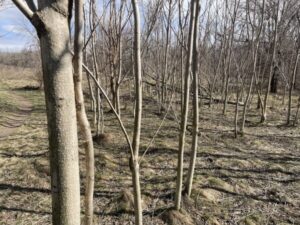
-
Grove of young Ailanthus.
-
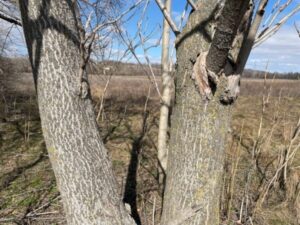
-
Ailanthus trees grow fast.
by Winding Pathways | Mar 14, 2024 | 1080 Labyrinth Blog, Labyrinths, Reflections/Profiles, Uncategorized
Who Is Stargirl?
Stargirl taught us to notice…to care. You know Stargirl, the spritely, hippie-seeming girl in the Jerry Spinelli story of the same title who showed up at a high school, wrote notes to people, played the ukelele, was nice to everyone, and even cheered the other team’s successes. She turned typical high school life upside down. And, then, vanished.
We walk today in her spirit. Usually ground underfoot is stone-cold and rigid. But with this “winter that hasn’t been” mole humps yield underfoot. We pause by the bell of the Phoenix Harmony Labyrinth.
Cookie Monster has nibbled the rim of the waning Gibbous moon as it slips west. Guided by moon shadows we walk.
-

-
Teri blesses the labyrinth
-
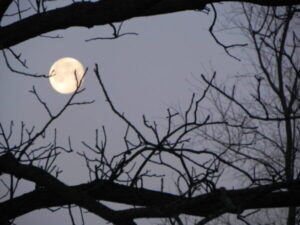
-
Tree branches help you watch the moon move across the sky.
From the south Mother West Wind shakes out the Merry Little Breezes. Off they skitter tickling the tops of the firs and rustling the winter-weary leaves of the Derecho-damaged oak.
Four Directions
Stop. Breathe in the air. Neither too cold nor too muggy. It’s Goldilocks. Just right.
To the east, a smear of red on the horizon separates the black earth from the velvet sky. Father Sun, starting to wake up, stretches his rosy fingers. Yet, stars still sprinkle the sky.
The ancient basswood tree full of gaping holes stands silhouetted. How did it survive when the sturdy oak shattered? Perhaps because it didn’t resist?
Totems
Vultures return in March. In fact, I saw one the other day soaring overhead. Checking out the basswood that has been home of vulture families for generations. Some people don’t like vultures because they are homely and eat dead stuff. Who among us is a Hollywood beauty?
As for eating dead stuff, good thing they do…One of Mother Nature’s cleanup crew. Otherwise, we would be knee-deep in rot. Maybe we are anyway. Good parents their keen eyesight and sharp smell lead them to meals which they feed their babies until they fledge.
Watching the young on their first flights as they swoop down, cross the labyrinth, then flap mightily to land in the fir on the far side is always a thrill. Vultures are good totems.
The pause by the birches feels like home. New England. Robert Frost wrote it well: “When I see birches bend to left and right Across the lines of straighter darker trees, I like to think some boy’s been swinging them. But swinging doesn’t bend them down to stay. Ice-storms do.”
Call and Response
Ahh, off in the woods a call and response as two cardinals awaken and call. A turkey gobbles from a tree top.
At the Center of the labyrinth, I thank the earth elements, plant and animal kingdom, those I have known. I send Grace to those I dislike, which helps me most. I stop and thank guides and Divine love.
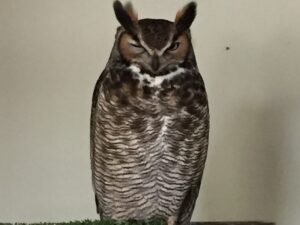
Injured owls find a safe home at the International Owl Center.
An owl floats past. Silent yet hearing, unseen yet seeing all. Quiet knowing. Carrying us through the night into the day.
To the north the Big Dipper’s handle swings off to Arcturus and look! A shooting star blazes brightly dropping into the North Star.
Stargirl is with us.
by Winding Pathways | Feb 29, 2024 | (Sub)Urban Homesteading, Home Improvements, Nature, Trees
Knot Just Lumber
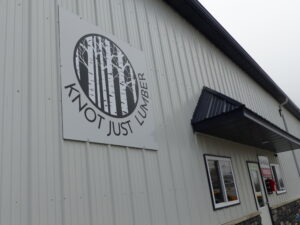
A local store
When driving through Hiawatha, Iowa, recently, a nondescript sign caught our eye. Posted on what looked like a warehouse the sign said, KNOT JUST LUMBER. We had to check it out and soon entered the ultimate wood candy store.
Leaning upright were immense slabs of white and red oak, walnut, cherry, and mulberry destined to become gorgeous tables. Nearby were smaller boards of at least a dozen tree species. Most were cut from native Iowa trees, but some racks held exotic wood from foreign lands. Purpleheart caught our eyes. It comes from trees that grow in Central and South America. When first cut the wood is dull grayish but within a few days, it transforms into an eggplant purple color.
Local Connections
We returned to visit Nic Carter, who co-owns the store with his sister, Caris. The family is from Alburnett and Nic was an active 4-H member dabbling in woods making jewelry boxes for art shows. After stints as a woodworker and home builder Nic, and his family opened Knot Just Lumber in September 2022. He and his sister decided to open the store because, “The area has no local woodworking place, so, I started one here,” he explained.
His father and son help run this family-owned and operated business located just north of Cedar Rapids. We enjoyed an in-person tour, which is augmented by their website and includes a virtual walk-through.
Knot Just Lumber caters to hobbyists, commercial customers, and families. We have visited several times and enjoyed chatting with individual customers and couples, and watched kids touch and smell the smooth, fragrant wood. The company buys trees from wood brokers. Most originate from trees in southern Iowa. The company mills wood into various-sized boards and turning rounds, dries it in an onsite kiln, surface planes, and sands most boards.
Wood is Special
Wood is special. We’ve noticed that in many brand-new houses doors, window frames, and floors are crafted from composite materials and plastic.
Nothing seems natural. In contrast, our 1947-era house has floors of Douglas Fir and White Oak with our furniture crafted from solid oak, pine, walnut, and cedar. Different woods make our home feel closer to nature while gracing us with the individual vibrant colors, textures, and grain patterns of each species. The woods connect us to woodworkers, friends, and craftspeople from bygone and current eras.
Commercial Lumber
Commercial lumber is usually cut from the straightest and most uniform trees. Buy it from a large commercial outlet and it’s attractive and easy to work but lacks the character implanted in wood by knots and irregular growth. In contrast, every wood slab we saw at Knot Just Lumber showed the individuality and character of the tree that created it. “Some of the most interesting wood comes from trees that grew in urban areas where their branches spread widely. It helps give the wood wonderful character and beautiful grain,” said Nic.
Unfortunately, every year millions of trees, many growing in towns, are felled after they die. Beautiful wood inside the bark is frequently hauled to a landfill, ground into shavings, or cut for firewood. Knot Just Lumber converts old veteran trees into lumber destined to be crafted into furniture that endures for generations. The company even saves sawdust and compresses it into briquettes to feed a wood stove or campfire. We bought some and found that they work wonderfully. We appreciated Nic’s caution that they do burn hot, so we use them sparingly. We are excited to use them with our occasional campfires out back.
-
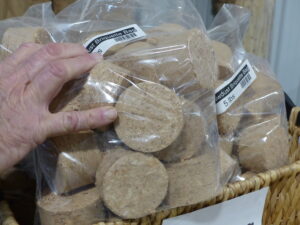
-
Value added and no waste.
-
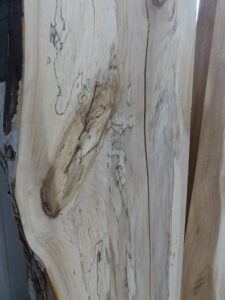
-
Fungi-laced wood
A Way to Add Character to a Room
The materials from our recent downstairs bathroom renovation are mostly manmade. That’s understandable, as the surfaces need to be easily cleaned and resist moisture. But the room needed the character of wood. So, we bought an oak board from Knot Just Lumber to cover a small area of plaster. It adds the warmth of nature to an otherwise utilitarian space.
Hidden Gems

Fusing old and new technology.
Knot Just Lumber is a local store we found by accident. The staff consult, have working spaces and classes for customers and specialize in epoxy with the wood to create gorgeous pieces for homes. Their prices are reasonable, especially compared to national stores or online sources. Similar local stores are scattered across the country. Finding them can be tricky but hobbyist woodworkers know where they are and anyone can Google hardwood lumber and they might learn of a nearby place to buy gorgeous local wood.
Resources
One of our favorite resources to learn the diverse characteristics of dozens of different species of native and exotic woods is the book WOOD! Identifying and Using Hundreds of Woods Worldwide, by Eric Meier.
-
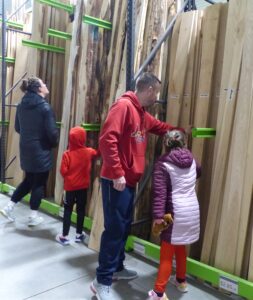
-
Families taking in the lumber.
-
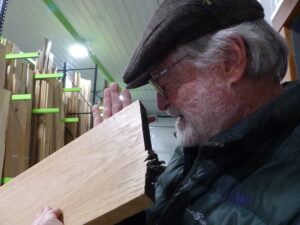
-
Assessing lumber.
-
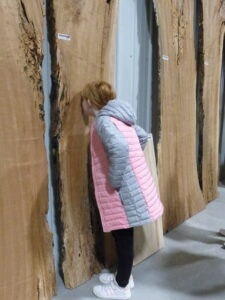
-
wood has a characteristic smell.
by Winding Pathways | Feb 22, 2024 | Birds, Mammals, Nature, Pests
We’ve blogged before about a white-footed mouse in the house. We read the story to our kids when they were little. Time after time we snuggled down with the book and they never got tired of hearing why the mouse might be cute but doesn’t belong in the house. A recent internet search for the specific book revealed lots of stories but not the one we wanted. Alas. So, here we are decades later writing again about a mouse in the house. Mice are cute but they do not belong in a house.
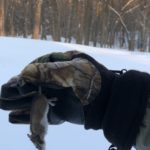
A person holding a mouse.
Whenever we’d find mouse evidence in our house, we’d set traps and usually catch a few, tossing their lifeless bodies outside for scavenger animals to eat. We do feel badly, but as the mother in the story said, “…a mouse does not belong in a house.”
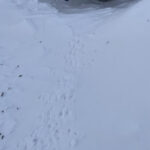
Path to the outdoor pantry
In January we changed our mind…..sort of. It was 20 below zero outside. Rich trudged through snow drifts to fill our bird feeders and noticed tracks, tiny mouse tracks, in the snow. A crafty white-footed mouse had scampered on top of the snow the night before to scrounge a few leftover seeds for dinner. Its tracks led to a snug nook out of the wind and under the deck.
An average White-footed mouse weighs a whopping .7 ounce. That’s seven-tenths of an ounce! That such a tiny creature can survive the howling wind and intense cold is a marvel of nature. Every nocturnal predator from coyotes to owls tries to capture and eat this diminutive mammal. But, it is wily, wary, and quick. Although not usually out during the day, it has to be mindful of cats and hawks looking for a meal.
-
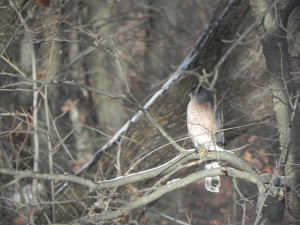
-
Patience
-
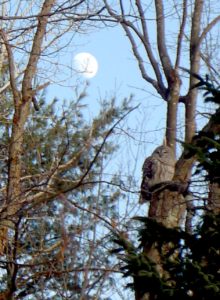
-
Nocturnal predator
After seeing those tracks, we felt a bit sorry for the animal that made them. We still won’t welcome a mouse into our house, but we’re happy it lives just outside in a safe place under the deck. He’s welcome to any seeds the birds overlooked.
To learn more about White Footed Mice and many other wild animals check out Animal Diversity Web out of the University of Michigan.
by Winding Pathways | Feb 15, 2024 | Preparedness
We were starting to pack for a winter trip to visit our Alaskan daughter when she called. “Bring gaiters along with your snowshoes,” she said. That sparked a lively conversation between us and piqued our curiosity.
Marion calls the item of clothing that keeps snow and dirt from getting into boots gaiters. Rich calls them spats. Who’s right? Well, we both are. Gaiters, spats, puttees, chaps, and leg warmers all are designed to protect legs, ankles, or feet from snow, dirt, or the cold. Some add a flair of fashion to their role of protection and they can be mostly decorative.
Gaiters
Gaiters are modern and popular with winter outdoor enthusiasts. Usually made of nylon or another synthetic fabric, they fasten over pant legs and shoes to keep grime and snow out. Unless a skier or snowshoer likes cold wet feet, gaiters are essential. Some gaiters have a chemical coating that helps protect from ticks, too.
-
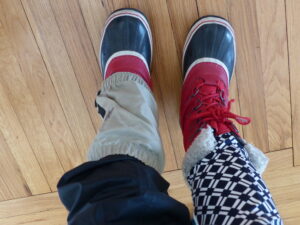
-
Ways to protect feet and legs.
-
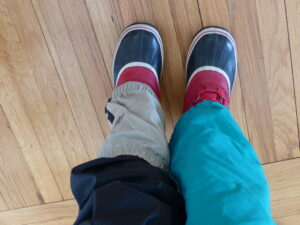
-
Long or short it is up to you.
Spats
Spats go way back. Rich remembers his Army days when soldiers wore bright white spats during formal ceremonies and parades. Spats is a shortened word for spatterdashes. Military ones were made of white canvas and may still be. Spats are usually short and worn over the lower trouser legs and shoes. Back a century ago stylish men and women often wore fancy spats on dress-up occasions. Today heavy-duty spats are made for protection, rather than fashion, and are worn by welders and construction workers to protect their feet and ankles from sparks and heavy falling objects.
Puttees
Pity the poor World War I soldiers who had to live in filthy, muddy trenches. Often, they wore puttees in an attempt to keep cold, grimy slime out of their shoes and off their lower legs. The Canadian War Museum explains that a puttee is a length of, usually, cotton material, somewhat like a bandage roll, that was wound around the ankle, lower pants legs, and upper parts of shoes. They were likely no match for a trench’s muck. Puttees are hardly ever used today and the name is nearly lost.
Leg Warmers
Leg Warmers emerged from a dancewear shop in the East Village. Designed to keep dancers’ legs and feet warm, they because fashion accessories. The 1983 movie Flashdance and Jane Fonda with her workout videos helped popularize these practical, stylish accessories throughout the ‘80s. They’re long tubes of colorful warm fabric that fit tightly over much of the legs. They haven’t gone away. Usually, they’re worn by women.
Chaps
Chaps are still another clothing item that are worn over the legs for protection. Cowboys wore them to fend off thorns. Loggers use them to protect their legs from wayward sharp chainsaw teeth. Rich spent a season logging in Idaho, where they were spelled chaps but pronounced shaps. Idaho’s unusual. In most other places people use the “c” sound. Chainsaw chaps have the amazing ability to stop a speeding chain’s teeth before tearing into the operator’s legs. They’re strictly for protection and anyone running a chainsaw is wise to wear them.
So, are they gaiters or spats? Do you pronounce them chaps or shaps? Take your pick, but however they are pronounced or called leg and ankle coverings offer protection, and some can be downright stylish. Just another way to be prepared in Iowa.


















